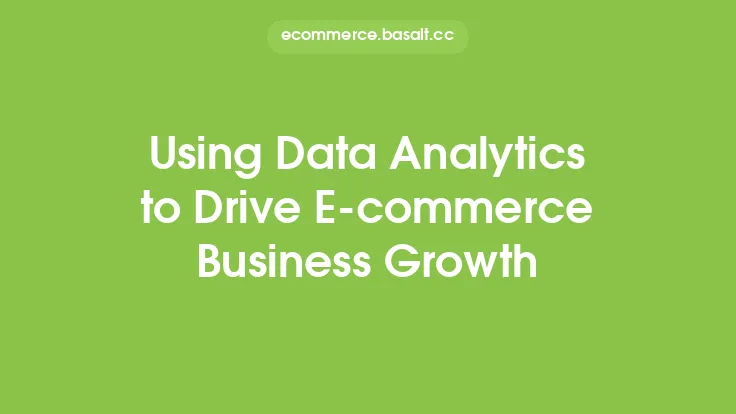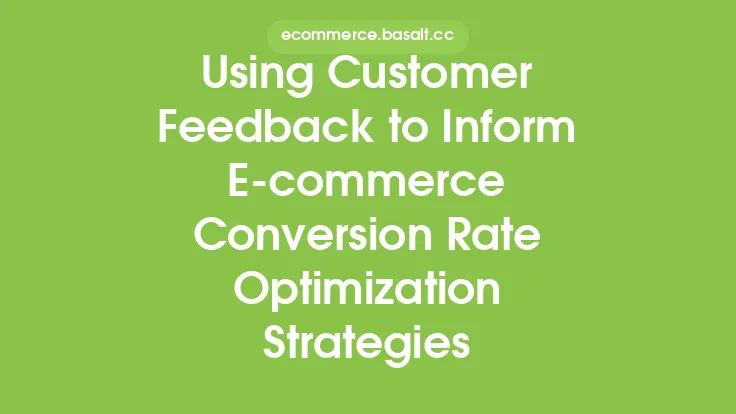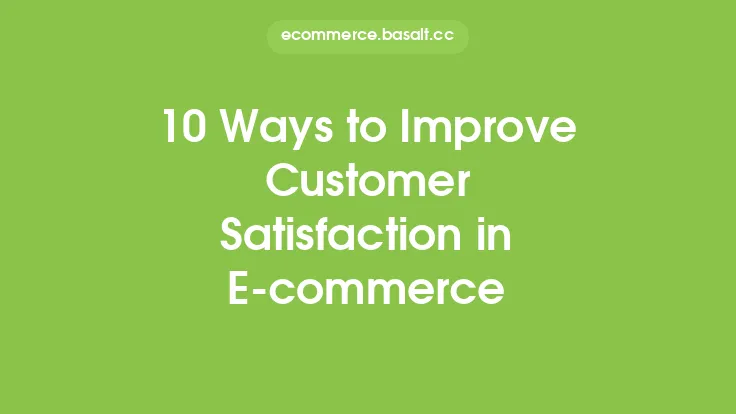In today's digital age, e-commerce has become an essential part of the retail landscape. With the rise of online shopping, businesses are looking for ways to improve the customer experience and stay ahead of the competition. One key way to achieve this is by using e-commerce analytics. E-commerce analytics involves the collection, analysis, and interpretation of data related to online shopping behavior, providing valuable insights into customer preferences, behavior, and needs. By leveraging e-commerce analytics, businesses can gain a deeper understanding of their customers and make data-driven decisions to enhance the overall shopping experience.
Introduction to E-commerce Analytics
E-commerce analytics is a powerful tool that helps businesses understand their online customers and optimize their e-commerce strategies. It involves tracking and analyzing various metrics, such as website traffic, conversion rates, average order value, and customer demographics. By analyzing these metrics, businesses can identify areas of improvement, optimize their marketing campaigns, and enhance the overall customer experience. E-commerce analytics can be applied to various aspects of online retail, including website design, product offerings, pricing, and customer service.
Benefits of E-commerce Analytics
The benefits of e-commerce analytics are numerous. By using e-commerce analytics, businesses can gain a competitive edge, increase revenue, and improve customer satisfaction. Some of the key benefits of e-commerce analytics include:
- Improved customer insights: E-commerce analytics provides valuable insights into customer behavior, preferences, and needs.
- Enhanced customer experience: By analyzing customer data, businesses can identify areas of improvement and optimize their e-commerce strategies to enhance the overall customer experience.
- Increased revenue: E-commerce analytics helps businesses identify opportunities to increase revenue, such as optimizing pricing, improving product offerings, and enhancing marketing campaigns.
- Better decision-making: E-commerce analytics provides businesses with data-driven insights, enabling them to make informed decisions about their e-commerce strategies.
Types of E-commerce Analytics
There are several types of e-commerce analytics, including:
- Descriptive analytics: This type of analytics involves analyzing historical data to understand what happened.
- Predictive analytics: This type of analytics involves using statistical models and machine learning algorithms to predict what may happen in the future.
- Prescriptive analytics: This type of analytics involves using data and analytics to provide recommendations on what actions to take.
- Diagnostic analytics: This type of analytics involves analyzing data to identify the root cause of a problem.
E-commerce Analytics Tools
There are many e-commerce analytics tools available, including Google Analytics, Adobe Analytics, and Salesforce Commerce Cloud. These tools provide businesses with a range of features, such as data tracking, analysis, and reporting. When choosing an e-commerce analytics tool, businesses should consider factors such as ease of use, scalability, and integration with other systems.
Best Practices for E-commerce Analytics
To get the most out of e-commerce analytics, businesses should follow best practices, such as:
- Setting clear goals and objectives: Businesses should define what they want to achieve with e-commerce analytics and set clear goals and objectives.
- Collecting and analyzing data: Businesses should collect and analyze data from various sources, including website traffic, customer demographics, and sales data.
- Using data to inform decisions: Businesses should use data and analytics to inform decisions about their e-commerce strategies.
- Continuously monitoring and optimizing: Businesses should continuously monitor and optimize their e-commerce strategies based on data and analytics.
Common E-commerce Metrics
There are many common e-commerce metrics that businesses should track, including:
- Conversion rate: The percentage of website visitors who make a purchase.
- Average order value: The average amount spent by customers in a single transaction.
- Customer lifetime value: The total value of a customer over their lifetime.
- Cart abandonment rate: The percentage of customers who abandon their shopping carts.
- Bounce rate: The percentage of website visitors who leave the site without taking any further action.
Using E-commerce Analytics to Improve Customer Experience
E-commerce analytics can be used to improve the customer experience in various ways, such as:
- Personalization: Businesses can use e-commerce analytics to personalize the shopping experience, such as recommending products based on customer behavior and preferences.
- Streamlining the checkout process: Businesses can use e-commerce analytics to identify areas of improvement in the checkout process and optimize it to reduce cart abandonment rates.
- Improving customer service: Businesses can use e-commerce analytics to identify areas of improvement in customer service and optimize it to enhance the overall customer experience.
- Enhancing product offerings: Businesses can use e-commerce analytics to identify areas of improvement in product offerings and optimize it to enhance the overall customer experience.
Challenges and Limitations of E-commerce Analytics
While e-commerce analytics can provide valuable insights into customer behavior and preferences, there are also challenges and limitations to consider, such as:
- Data quality: Poor data quality can lead to inaccurate insights and decisions.
- Data overload: Too much data can be overwhelming, making it difficult to identify key insights and trends.
- Limited resources: Small businesses may not have the resources or expertise to implement and use e-commerce analytics effectively.
- Privacy concerns: Businesses must ensure that they are collecting and using customer data in a way that is transparent and respectful of customer privacy.
Future of E-commerce Analytics
The future of e-commerce analytics is exciting, with emerging trends and technologies, such as artificial intelligence, machine learning, and the Internet of Things (IoT). These technologies will enable businesses to collect and analyze even more data, providing deeper insights into customer behavior and preferences. Additionally, the use of cloud-based e-commerce analytics tools will become more prevalent, enabling businesses to access and analyze data from anywhere, at any time.
Conclusion
In conclusion, e-commerce analytics is a powerful tool that can help businesses improve the customer experience, increase revenue, and gain a competitive edge. By leveraging e-commerce analytics, businesses can gain valuable insights into customer behavior and preferences, identify areas of improvement, and optimize their e-commerce strategies. While there are challenges and limitations to consider, the benefits of e-commerce analytics far outweigh the costs. As the e-commerce landscape continues to evolve, businesses that invest in e-commerce analytics will be well-positioned to succeed and thrive in the digital age.





